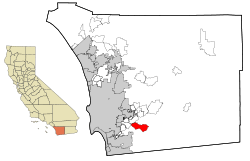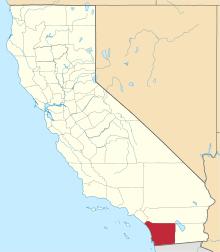Jamul Indian Village
 San Diego County, Jamul is highlighted in red | |
| Total population | |
|---|---|
| 60[1]–120 enrolled members[2] | |
| Regions with significant populations | |
|
| |
| Languages | |
| Ipai,[3] English | |
| Religion | |
|
Traditional tribal religion, Christianity (Roman Catholic) | |
| Related ethnic groups | |
| other Kumeyaay tribes, Cocopa, Quechan, Paipai, and Kiliwa |
The Jamul Indian Village of California is a federally recognized tribe of Kumeyaay Indians, who are sometimes known as Mission Indians.[4]
Reservation
The Jamul Indian Village is a federal reservation, located 10 miles (16 km) southeast of El Cajon, in southeastern San Diego County, California.[4] It was established in 1912.[5] It is six acres (24,000 m2) in size.[6] No one lives on the reservation although 20 members lived there in the 1970s.
Language
The traditional language of the Jamul Indian Village and their larger tribal group, the Kumeyaay, is from the Tipai language grouping. The influence of the Spanish Mission system on the retention of the Jamul Indian Village native tongue can be observed as there are only a small amount of less than 100 tribal members who retain their native language.[7] The Jamul Indian Village as well uses English in modern times as a primary language for communication.
Government
The Jamul Indian Village is headquartered in Jamul, California. The current government for the Jamul Indian Village is a democratically elected tribal council. As of June 2017 Jamul Tribal Council consist of
Erica M. Pinto, Chairwoman
Mike Hunter, Vice-Chairman
Christopher Pinto, Secretary
Richard Tellow, Treasurer
James Cuero III, Councilman
Teresa Cousins, Councilwoman
Jesse Pinto Sr., Councilman.[8]
History
Starting 12,000 years ago the tribal members of the Jamul Indian Village started their roots. The tribe studied and understood their environment and tried their best in tradition and practice to honor the land they were blessed with calling their home. They used to practice basket weaving and traditional hunting and other games. They would perform cultural burnings and use the land in equilibrium with what it provided. The European contact caused a stir with the tribe as they had lost a large portion of their traditions to the forced assimilation brought upon their tribe. However many generations later many of their traditions have been revived and practiced and now there is a large group of tribal members honoring their ancestors.[7] The tribe in 2016 opened the Hollywood Casino Jamul and now it provides a large source of income through their newly built casino.[9] San Diego government officials still grapple with the impact of the controversial casino onto the local community.[10]
Notes
- ↑ "California Indians and Their Reservations: P. SDSU Library and Information Access: Population. (retrieved 22 May 2010)
- ↑ Pritzker, 146
- ↑ Eargle, 118
- 1 2 "California Indians and Their Reservations: J. SDSU Library and Information Access. (retrieved 22 May 2010)
- ↑ Shipek, 613
- ↑ Pritzker, Barry (2000). A Native American Encyclopedia: History, Culture, and Peoples. Oxford University Press. p. 146. ISBN 9780195138771.
- 1 2 "Our History" Jamul Indian Village, a Kumeyaay Nation. (retrieved 15 March 2017)
- ↑ "Tribal Government" Jamul Indian Village, a Kumeyaay Nation. (retrieved 15 March 2017)
- ↑ "Tribal Gaming" Jamul Indian Village, a Kumeyaay Nation. (retrieved 15 March 2017)
- ↑ Pearlman, Karen. "Jacob is keeping tabs on Highway 94 traffic since casino opening". sandiegouniontribune.com. Retrieved 2018-01-31.
References
- Eargle, Jr., Dolan H. California Indian Country: The Land and the People. San Francisco: Tree Company Press, 1992. ISBN 0-937401-20-X.
- Shipek, Florence C. "History of Southern California Mission Indians." Handbook of North American Indians. Volume ed, Heizer, Robert F. Washington, DC: Smithsonian Institution, 1978. 610-618. ISBN 0-87474-187-4.
External links
- Jamul Indian Village, official website
Coordinates: 32°42′10″N 116°52′15″W / 32.70278°N 116.87083°W
